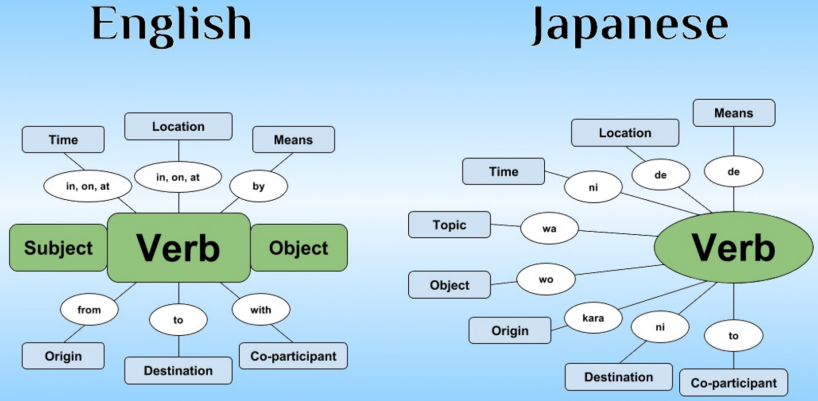塸暥撉夝偐傜擖帋傑偱丂姰慡儅儞僣乕儅儞巜摫
弇挿偺僐儔儉丂俀侽侾俋擭俇寧侾俆擔丂 亀庡岅偺奣擮 嘇 銹拝岅偲孅愜岅嘥亁
 |
 |
|
庡岅偺奣擮 嘇 銹拝岅偲孅愜岅 |
||
俀侽侾俋擭俇寧侾俆擔 奆條丄KVC Tokyo 塸岅弇丂弇挿丂摗栰丂寬偱偡丅 丂尵岅宍懺榑偱偼丄擔杮岅偼銹拝岅丂agglutinative language丄堦曽僀儞僪儓乕儘僢僷岅懓偵娷傑傟傞墷暷岅偼孅愜岅 inflected langage 偵暘椶偝傟傑偡丅奆偝傫偼偙傟傜偺愱栧梡岅傪帹偵偟偨偙偲偑偁傞偐傕偟傟傑偣傫偑丄尩傔偟偄岅姶偑姶偠傜傟摝偘弌偟偨偔側偭偨曽傕偄傞偩傠偆偲憐憸偟傑偡丅銹拝偲偼僯僇儚乮摦暔偺崪傗掻丄旂傪幭媗傔偰嶌傞屝乯偱揬傝晅偗傞偲偺堄枴偱偡偑丄擔杮岅偩偲銹拝忬懺偺弉岅傕偁傝岅姶偑椙偔偁傝傑偣傫丅扨岅側傞亙晹昳亜摨巑偑屝偱偔偭偮偔掱搙偺寉偄堄枴偲偟偰丄椺偊偽亙愙拝尵岅亜側偳偵夵徧偟偨傜偳偆偱偟傚偆偐丠傑偀丄奺乆撈棫偟偨扨岅偵丄亙偰偵傪偼亜傪屝偲偟偰巊偭偰摦帉側偳偺彇弎岅側偳偵亙揬傝崌傢偣傞亜偙偲偱堄枴昞尰壔偡傞尵岅偱偡偹丅堦曽孅愜偼丄壗傕尵梩偑僕僌僓僌撌墯偵愜傟嬋偑傞栿偱偼柍偔丄妶梡偡傞偲偺堄枴偱偡偺偱丄岆夝傪彽偔偲尵偆偐堄枴晄柧側孅愜偺擔杮岅栿偼巭傔丄扅偺妶梡尵岅偲屇傋偽媂偟偄條偵傕巚偄傑偡丅扨岅偑僑儉偺朹偱偁傟偽丄庤偱埇傝偟傔偨婎晹乮岅姴乯偼曄壔偣偢偲傕丄偦偺愭乮妶梡岅旜乯偑嵍偵塃偵偲僽儗偰愜傟嬋偑傞丄偲偺楢憐偐傜惣梞偱偼偙偺岅傪摉偰偨偺偐傕抦傟傑偣傫丅偙偭偪偼丄扨岅乮懡偔偼偦偺岅旜乯偑妶梡偡傞偙偲偱堄枴昞尰傪峴偆尵岅偱偡丅亙偰偵傪偼亜帺懱傪扨岅偺拞偵娷傓尵岅懱宯偲峫偊傟偽椙偄偱偟傚偆丅fusional langage 乮梈崌尵岅偲偱傕栿偟傑偡偐乯偲偺暿柤傕偁傝傑偡偑丄亙偰偵傪偼亜傪庢傝崬傫偱扨岅偑梈崌偟偨偲偺堄枴偱偡偹丅扐偟丄偙傟傜銹拝岅丄孅愜岅偺嬫暿偼尩枾側傕偺偱偼偁傝傑偣傫丅幚嵺丄塸岅帺懱偼摦帉妶梡偑扨弮壔偡傞偲嫟偵慜抲帉乮堦庬偺亙偰偵傪偼亜乯巊梡偺斾廳偑崅傑傝丄銹拝岅壔偺掱搙偑恑傫偱棃偰偄傞偺偼妋偐偵姶偠傑偡丅僀儞僪儓乕儘僢僷岅懓偱桳傝側偑傜傕丄妶梡傪娙棯壔偟丄銹拝岅偺惈幙傪揨偆偙偲偱丄帠幚忋偺嫟捠岅偲偟偰晛媦偟偨偲傕尵偊偦偆偱偡丅偲偼尵偭偰傕塸岅傪戞堦尵岅偲偡傞榖幰寳帺懱偼塸崙杮崙暲傃偵偦偺媽怉柉抧偵棷傑偭偰偼偄傑偡偑丅 丂梋択偱偡偑丄僼傿儞儔儞僪偺僶儖僩奀傪嫴傫偱偺懳娸偵偁傞僄僗僩僯傾偱偼丄僼傿儞儔儞僪岅偲摨偠銹拝岅偲偝傟傞僄僗僩僯傾岅乮僼傿儞儔儞僪岅偵嬤偄乯偑榖偝傟傑偡偑丄僪僀僣岅側偳偺塭嬁偱丄師戞偵孅愜岅壔偑恑峴偟偰偄傞偲偺偙偲偱偡丅尵岅岎懼乮偘傫偛偙偆偨偄乯偺侾椺偱偡偑丄塸岅偲偼恀媡偺恑壔曽岦偱偡偹丅 埲壓丄杮僐儔儉幏昅偺嶲峫僒僀僩丗https://ja.wikipedia.org/wiki/銹拝岅https://en.wikipedia.org/wiki/Agglutinative_language亙愙拝尵岅亜偺栿偱暘偐傝堈偔偰椙偄偺偱偼偲峫偊傑偡丅cf. glue 偺岅尮https://www.etymonline.com/word/glue"to stick together丂屳偄偵偔偭偮偔傕偺丄屝丄丂clay 擲搚傕摨崻https://ja.wikipedia.org/wiki/孅愜岅亙妶梡尵岅亜偺栿偱暘偐傝堈偔偰椙偄偺偱偼偲峫偊傑偡丅https://en.wikipedia.org/wiki/Fusional_language暿柤inflected langage亙梈崌尵岅亜偺栿偱暘偐傝堈偔偰椙偄偺偱偼偲峫偊傑偡丅cf. inflect 偺岅尮https://www.etymonline.com/word/inflectinflect (v.)early 15c., "to bend inward," from Latin inflectere (past participle inflexus) "to bend in, bow, curve," figuratively, "to change, alter, influence," from in- "in" (see in- (1)) + flectere "to bend" (see flexible). Grammatical sense "to vary by change of form" (especially at the end of a word) is from 1660s. Related: Inflected; inflecting.丂撪懁偵岦偐偭偰愜傟嬋偑傞偑尨媊丅宍幃乮摿偵扨岅偺岅旜乯傪曄壔偝偣傞偲偺暥朄忋偺堄枴偼侾俇俇侽擭偵巊梡偑巒傑傞丅仏媗傑傝偼暥朄忋偺堄枴偼嵟弶偐傜妶梡偺堄枴偱偁傝丄偍偦傜偔丄摉帪偼揔摉側尵梩尒摉偨傜側偄偺偱1660 擭偵側傝 inflect 偺岅傪摉偰偨偺偱偟傚偆丅懠曽僼儔儞僗岅偱偼 flexion 偺岅傪摉偰傑偡丅https://fr.wiktionary.org/wiki/flexion(Grammaire) Modification de la forme d乫un mot par rapport a ce qui est considere comme sa forme de base, par la conjugaison et la declinaison.https://ja.wikipedia.org/wiki/僄僗僩僯傾岅https://ja.wikipedia.org/wiki/尵岅岎懼 |
||
 |
 |
The Finnish Language丂Langfocus丂2016/05/20 偵岞奐
This video is a mini-documentary about the Finnish Language. First I investigate
the history of the Finnish language before dissecting some of its important features.
https://youtu.be/D-uWYvlyeBc
枅搙偺億乕儖偺尵岅夝愢摦夋偱偡丅僼傿儞儔儞僪岅偼銹拝岅偱丄a, the 偺姤帉傕丄
柤帉偺惈傕柍偔丄傑偨摦帉偺枹棃宍偑側偄揰偱擔杮岅偵帡偰偄傑偡丅僼傿儞儔儞僪
恖偼塸岅傪棳挩偵榖偟傑偡偑丄挿傜偔僗僂僃乕僨儞偵巟攝偝傟丄報墷岅偵撻傟恊
偟傫偱偒偨楌巎揑攚宨偑偁傝偦偆偱偡丅偦偺揰偼椙偐傟埆偟偐傟亙嬌搶偺僈儔僷
僑僗搰亜嵼廧偱丄撈帺暥壔傪崅搙偵敪払丒愻楙偝偣偰偒偨擔杮恖偲偼戝堘偄偱偡丅

https://8020japanese.com/wp-content/uploads/jp-sentence-structure/En-vs-Jp-structure.jpg
In: https://8020japanese.com/japanese-sentence-structure/
塸岅偲擔杮岅偺峔憿揑堘偄傪帵偡恾丅塸岅偱偼奺庬偺慜抲帉傪巊偆揰偱丄擔杮岅偺彆帉
乮屻抲帉偲屇傋側偔傕柍偄丄屝偵憡摉乯偺棙梡偲帡偰偄偰銹拝岅壔偑恑傫偱棃偰偄傞條偵
尒偊傑偡丅擔杮岅偱偼偄傢備傞庡岅偱偝偊丄摦帉乮偙傟偼暥枛偵抲偐傟傞乯傪廋忺偟庢傝姫
偔梫慺偺侾偮偵夁偓傑偣傫丅儔僥儞岅偺応崌偼丄嵍偺恾偱丄Subject 偲慜抲帉偺俀偮傪摦帉
Verb 侾偮偺拞偵墴偟崬傫偱侾偮偵偟偨傛偆側宍懺偺尵岅乮偦偺暘妶梡偼暋嶨壔偡傞乯偲峫
偊傟偽暘偐傝堈偄偺偱偼偲巚偄傑偡丅尵岅宍懺揑偵偼丄忋偺嵍塃偺恾偵偰丄偁偲偼摦帉
偺帪惂丄媗傑傝偼尰嵼夁嫀枹棃偺偁傝曽傪峫偊傟偽婎杮揑側棟夝偼廔傢傝偦偆偱偡丅
偙偺條側尵岅峔憿偺堘偄乮尵岅宍懺榑乯偐傜丄偳偆偟偰塸岅偑悽奅偵晛媦偟偨偺偐丄
偦偺棟桼傪峫媶偡傞偺傕偄偭傁偟偺榑暥偵側傝偦偆偱偡偹丅
 |
 |
|
丂柺敀偄婰帠偑傒偮偐傝傑偟偨偺偱偛徯夘偟傑偟傚偆丅塸岅榖幰岦偗偵擔杮岅偺摿挜傪愢柧偡傞傕偺偱偡偑丄戝曄桪傟偨撪梕偩偲巚偄傑偡丅https://8020japanese.com/japanese-sentence-structure/Japanese Sentence Structure: The Ultimate Beginner乫s GuideEnglish vs Japanese sentence structureMost people find Japanese sentence structure to be difficult and confusing.This is completely understandable considering how fundamentally different it is to other languages, but the truth is that Japanese grammar is actually incredibly logical ? it just needs to be looked at from the right angle.Usually, the basic structure of Japanese sentences is considered to be SOV ? subject-object-verb (eg. I sushi eat). This description makes it easier to compare with English, for example, which follows an SVO structure, but the truth is, this comparison is mostly meaningless because 丂the two languages function in completely different ways. The SOV label is also wrong sometimes, as it is not uncommon in Japanese to see sentences with the object appearing before the subject. No wonder it seems so confusing乧Instead of trying to fit a Japanese-shaped peg into an English-shaped hole, let乫s start again.Firstly, in English, the main pieces of a sentence go in a specific order. The person doing the action (the subject, eg. I) 丂is first, followed by the word that describes the action (the verb, eg. eat), then the thing that the action is done to (the object, eg. sushi). In English, it is the word order that tells us who did what.Japanese sentences are structured around grammatical markers called 乪particles乫. Each particle indicates how the word before it relates to other words in the sentence, usually to the verb. The verb appears last, but the order of the other words can vary because it is the particles, not word order, that tell us who did what.For example, a basic sentence might have a topic (which is often the same as the subject) followed by the particle 乪wa乫, then an object with the particle 乪wo乫, and finally the verb. This basic word ordering is why Japanese is often considered an SOV language, but as long as the right particles are used with the right words, the actual order of the words can be changed.丂乮榓栿偼師夞嘊偵懕偔乯 |
||
 |
 |
擔杮岅偲僩儖僐岅偺惁偄椶帡 - 僷乕僩 1
2020/07/31丂vacationintheuniverse
https://youtu.be/FRMhkqovbwY
擔杮岅偲僩儖僐岅偼暥復偺憿傝宆偑嬃偔傎偳椶帡偟偰偄傑偡偑丄侾偮偺愢偱偼丄僩儖僐亅拞墰傾僕傾
亅儌儞僑儖亅挬慛敿搰亅擔杮岅偼堦楢偺岅懓偵偁傞偲乮傾儖僞僀岅懓乯偝傟傑偡丅栟傕丄僩儖僐偐傜拞
墰傾僕傾偵妡偗偰偺僥儏儖僋宯尵岅摨巑偼偁傞掱搙傑偱偼堄巚慳捠偑壜擻偱偡偑丄懠摨巑偼峔惉
偝傟傞扨岅侾偮侾偮偵嫟捠揰偑側偄掱傑偱偵暘抐丄屒棫壔偟偰偄傑偡丅暥朄偺僞僱偼摨崻偩偑丄奼
嶶偟偰屻丄屳偄偵岎棳柍偔晻報偝傟偰帪娫偑宱夁偟偨壜擻惈偑偁傝傑偡丅擔杮岅偲棶媴岅偼堎側傞
尵岅偲偟偰暘棧偡傞捈慜偺忬懺偱偟傚偆偐丠弇挿偼壂撽曉娨屻俀擭屻偵椃峴偟傑偟偨偑丄尰抧偺恖
摨巑偺夛榖偑慡偔棟夝弌棃傑偣傫偱偟偨丅
Altaic: Rise and Fall of a Linguistic Hypothesis
2019/09/29 NativLang
Languages throughout Asia are startlingly similar, but are they all part of one huge
family? Thus began the biggest fight in the history of historical linguistics.
https://youtu.be/z0zkHH6ZOEk
傾儖僞僀岅懓偲偟偰揨傑傞偐偵偮偄偰偼丄嫟捠慶愭傪帩偮偺偱偼柍偔屳偄偵墶曽岦偱塭嬁偟偁偭偨寢壥偩偲偡傞愢傕採弌偝傟偰偄傑偡丅尵岅娫偺椶帡惈丄宯摑惈傪扵傞偵摉偨傝丄扨岅偺嫟捠惈傪斾妑偟傛偆偲偺曽朄偑廬棃嵦傜傟偰棃傑偟偨偑丄偳偆偟偰傕湏堄揑側尵梩偺慖戰偲偙偠偮偗偨夝庍偵側傝偑偪偱偁傝丄弇挿傕偙偺條側曽朄榑偑忢偵惉棫偡傞偲偼峫偊偰嫃傑偣傫丅偙偺摦夋偵婑偣傜傟偨僐儊儞僩偵丄Weilong Guan
I'm a Manchu from Beijing, I speak a little Manchu and a little Mongol, when I learned Turkish in Istanbul I found the grammar and vocab surprisingly matching (excluding Islamicborrowings in Turkish and Tibetan Buddhist borrowings in Manchu/Mongol). All those suffixes and conjugations are nearly the same.
Other than that my grandpa (Manchu) and grandma (Mongolian) could communicate with each other speaking their native languages (plus Chinese and Tibetan) 丂偲偁傝傑偟偨偑丄暥朄峔憿柺偱嫮屌側椶帡惈偑屳偄偵偁傞偲尒傜傟丄屄乆偺扨岅偺嬤帡惈傛傝偼偙偪傜偺曽傪廳帇偟偰岅懓傪懆偊傞傋偒偲峫偊傑偡偑擛壗偱偟傚偆偐丠
 |
 |
|
丂擔杮岅榖幰偺堦恖偱偁傞弇挿偐傜偡傞偲丄彆帉側傞曋棙側愙拝嵻偱扨岅乮妶梡宆偑彮側偄乯摨巑傪揬傝崌傢偣偰堄巚昞帵傪峴偆擔杮岅偺曽偑儔僋側條偵姶偠傑偡丅傑偀丄擔杮岅妛廗偼傂傜偑側偲僇僞僇僫偺悽奅偵棷傑傞尷傝偱偼堈偟偄柾條偱偡偑丄娍帤廗摼偺柺偲側傞偲墷暷岅榖幰偺慜偵偼堦婥偵暻偑棫偪傆偝偑傝傑偡偹丅 |
||
 |
 |


